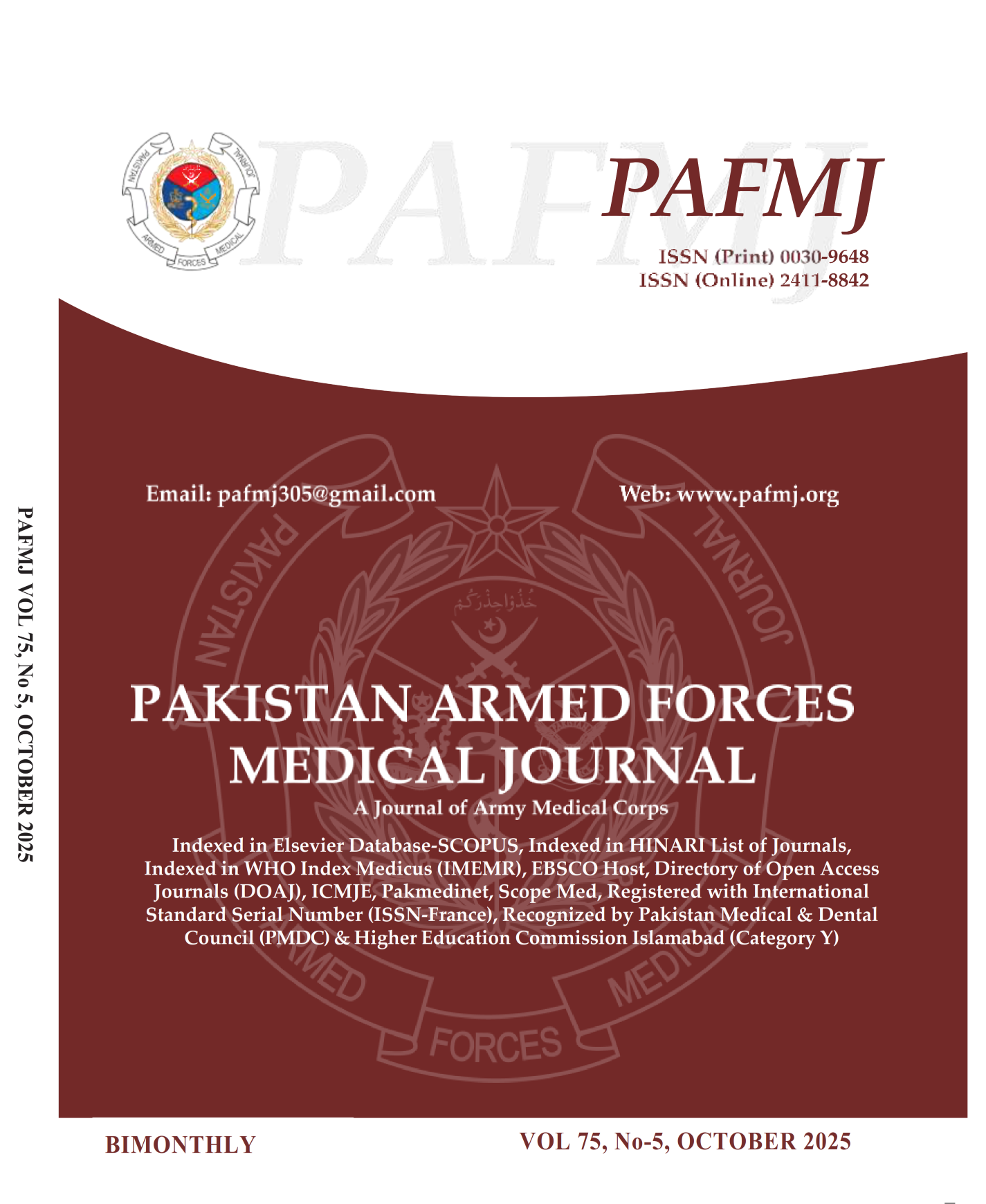Clinical Analysis of Physiological Drifting of Adjacent Teeth Following Full Crown Preparatio
DOI:
https://doi.org/10.51253/pafmj.v75i5.11842Keywords:
Crown, Mesial drift, Physiological, TeethAbstract
Objective: To compare the physiological drifting of adjacent teeth between young adults versus middle aged patients following full crown preparation.
Study Design: Quasi-experimental study.
Place and Duration of Study: Department of Prosthodontics, Armed Forces Institute of Dentistry, Rawalpindi, Pakistan from Jun-Dec 2023.
Methodology: A total of 140 patients were assessed for inclusion in the study and divided into two groups: Group A (young adult group) and Group B (middle-aged group). Once preparation of tooth to be crowned was completed, inter-space between two teeth adjacent for crowning was measured using a standard digital Vernier caliper by a consultant. Patients were counselled to follow-up for subsequent setting of the crown after 10 days and drifting was checked and measured again before crown placement by digital vernier caliper and endorsed accordingly. Primary variables observed were mesial drifting following pre-crown preparation reviewed after 10 days between both age groups and number of patients requiring re-adjustment for crowning due to change in space.
Results: Mean mesial drift post-preparation for crown when assessed at 10 days was 0.04±0.008 mm in the young adult groups versus 0.01±0.006 mm in the middle-aged patient group (p<0.001). Subsequently, patients that required re-adjustment due to drift because of crowning were 31(44.3%) patients in the young adult group versus 19(27.1%) patients in the middle-aged patient group (p=0.034)
Conclusion: Mesial drift affects the crowning process more in the young adult age group than the middle age group with more re-adjustment before crowning required in younger age patients.
Downloads
References
1. Rezaie F, Farshbaf M, Dahri M, Masjedi M, Maleki R, Amini F, et al. 3D Printing of Dental Prostheses: Current and Emerging Applications. J Compos Sci 2023; 7(2): 80.
https://doi.org/10.3390/jcs7020080
2. Zhang Y, Kelly JR. Dental ceramics for restoration and metal veneering. Dent Clin North Am 2017; 61(4): 797-819.
https://doi.org/10.1016/j.cden.2017.06.005
3. Rauch A, Schrock A, Schierz O, Hahnel S. Material selection for tooth-supported single crowns—a survey among dentists in Germany. Clin Oral Investig 2021; 25: 283-293.
https://doi.org/10.1007/s00784-020-03568-y
4. Ding H, Cui Z, Maghami E, Chen Y, Matinlinna JP, Pow EHN, et al. Morphology and mechanical performance of dental crown designed by 3D-DCGAN. Dent Mater 2023; 39(3): 320-332.
https://doi.org/10.1016/j.dental.2023.01.003
5. Ansari SH, Alfaqeeh AA, Al Buryk A, Alfaqeeh SA, Almusharraf AYA, Aljarullah AHN. Indications and Success Rate of Endo Crowns--A Systematic Review. J Evol Med Dent Sci 2020; 9(43): 3247-3252.
https://doi.org/10.14260/jemds/2020/711
6. Nicklisch N, Hinrichs C, Palaske L, Vach W, Alt KW. Variability in human tooth cementum thickness reflecting functional processes. J Periodontal Res 2023; 58(3): 491-500.
https://doi.org/10.1111/jre.13106
7. Kuruthukulam RM, Patil AS. The center of resistance of a tooth: a review of the literature. Biophys Rev 2023; 15(1): 35-41.
https://doi.org/10.1007/s12551-022-01039-0
8. Tiwari VC. Driftodontics in Orthodontic Treatment: A Review. J Adv Med Dent Sci Res 2020; 8(2): 124-127.
9. Voudouris JC, Voudouris JD, Nicolay O, Glaser B, Nicozisis J, Theodoridis G, et al. Clear aligners, dentofacial orthopedics, physics and supercorrection prescription biomechanics. A meeting of the minds. Semin Orthod 2022; 28(3): 155-170.
https://doi.org/10.1053/j.sodo.2022.10.008
10. Othman A, Sandmair M, Alevizakos V, von See C. The fracture resistance of 3D-printed versus milled provisional crowns: An in vitro study. PLoS One 2023; 18(9): e0285760.
https://doi.org/10.1371/journal.pone.0285760
11. Adnan HH, Hassan AFA. Biology of Tooth Movement. In: StatPearls. StatPearls Publishing; 2022. Available from:
https://www.ncbi.nlm.nih.gov/books/NBK572109/
12. Dutta SR, Passi D, Singh P, Atri M, Mohan S, Sharma A. Risks and complications associated with dental implant failure: Critical update. Natl J Maxillofac Surg 2020; 11(1): 14-19.
https://doi.org/10.4103/njms.NJMS_75_16
13. Liuti T, Daniel CR, Dixon PM, Reardon RJ. Studies on Age-Related Changes in Equine Cheek Teeth Angulation and Dental Drift. Front Vet Sci 2022; 8: 804061.
https://doi.org/10.3389/fvets.2021.804061
14. Giannetti L, Apponi R, Mordini L, Presti S, Breschi L, Mintrone F. The occlusal precision of milled versus printed provisional crowns. J Dent 2022; 117: 103924.
https://doi.org/10.1016/j.jdent.2021.103924
15. Jaber AA, Alshame AM, Abdalla KO, Natarajan PM. The association between teeth loss and oral health problems. Indian J Forensic Med Toxicol 2021; 15(1): 1892-1902.
16. Papageorgiou SN, Antonoglou GN, Michelogiannakis D, Kakali L, Eliades T, Madianos P et al. Effect of periodontal–orthodontic treatment of teeth with pathological tooth flaring, drifting, and elongation in patients with severe periodontitis: A systematic review with meta‐analysis. J Clin Periodontol 2022; 49: 102-120.
https://doi.org/10.1111/jcpe.13569
17. Jennes M-E, Sachse C, Flügge T, Preissner S, Heiland M, Nahles S. Gender-and age-related differences in the width of attached gingiva and clinical crown length in anterior teeth. BMC Oral Health 2021; 21(1): 193.
https://doi.org/10.1186/s12903-021-01560-w
18. Baker J, McColl E, Tredwin C. Top tips for improving crown preparations. Br Dent J 2023; 234(1): 16-18.
https://doi.org/10.1038/s41415-023-5463-z
19. Rizzante F, Bueno T, Guimarães G, Moura G, Teich S, Furuse A, et al. Comparative physical and mechanical properties of a 3D printed temporary crown and bridge restorative material. J Clin Exp Dent 2023;15(6):e464-e471.
Downloads
Published
Issue
Section
License
Copyright (c) 2025 Anis Rehman, Mubashir Sharif, Sana Khalid, Asifa Abbas, Syed Junaid Hussain Bukhari, Ahmed Abdullah

This work is licensed under a Creative Commons Attribution-NonCommercial 4.0 International License.















